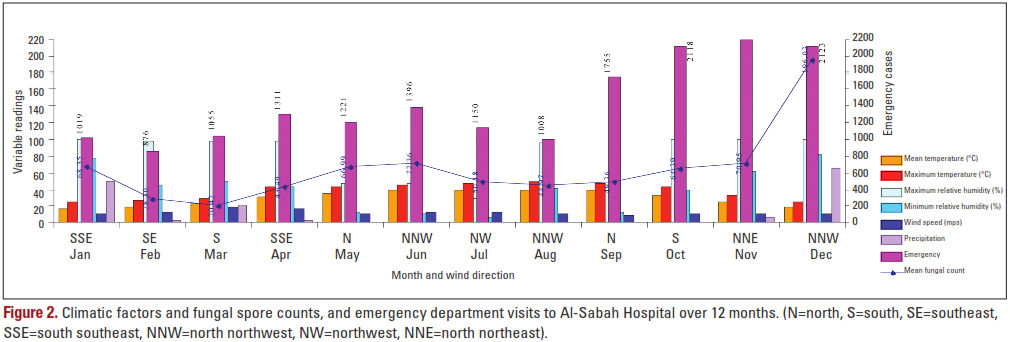The prevalence of asthma has been on the increase in many countries and this has led to the need for relevant studies to be done to investigate the causes of such respiratory diseases. Qasem and his colleagues (2008) did a research to investigate the relationship between the meteorological factors and the number of asthma patients in Kuwait. Their results indicated that the climatic conditions in the area favoured the current quantity of aerial fungal spores in the environment. The amount of humidity, for example, was correlated to the amount of such spores in the air. There was an indication that the temperature also favoured the abundance of the fungal spores. The patient admissions also indicated a seasonal distribution. During the winter and autumn seasons, patient admissions were highest. During spring and summer, on the other hand, the least number of such admissions were recorded (Qasem, 2008, p. 436). In this study, only asthma was studied.
Newhouse and Levetin (2003) also conducted a study to find the correlation between the airborne fungal spores, the concentration of pollen, meteorological factors and other pollutants, and the occurrence of rhinitis (hay fiver) and asthma. From the study, the authors found out that the climatic factors, the types of pollen and the ozone level were positively correlated to the occurrence of symptoms of those conditions. The spores that caused asthma and rhinitis were affected by humidity, temperature, atmospheric pressure and precipitation (Newhouse & Levetin, 2003, p. 363).
Safa and Machado (2003) explained how a respiratory disease could be contracted through the inhalation of dust. Respirable crystalline silica dust is one of the agents of pulmonary fibrosis (as explained by the authors). They interpreted a case report that involved an Afghani housewife who was complaining of having a dry cough and showed symptoms suggesting the presence of an occupational respiratory disease. These symptoms began to show when she relocated to the United Arab Emirates. They suggested that such dust (silica) could be inhaled by individuals working in mining fields, construction sites and various manufacturing industries. However, they are also abundant in domestic cleaning powder. The authors stated that silicosis is quite rare and may at times be misdiagnosed. Therefore, they advised that it is important for physicians to check the patient’s occupational history in order to properly diagnose this condition (Safa & Machado, 2003, p.103). In a similar study, Al-Neaimi, Gomes and Lloyd (2001) also studied the association between cement dust inhalation and respiratory illnesses. They concluded that such dust was associated with illnesses and conditions such as dyspnoea, sinusitis, bronchial asthma and phlegm.
In another related study, Oberg and his colleagues (2010) were seeking to understand the burden of disease due to exposure to second-hand smoke. Second-hand smoke is one of the causes of indoor pollution. Such exposures had resulted to the death of over 350,000 individuals. The causes included lower respiratory infections, asthma, among other diseases. The children were most affected by lower respiratory infections while the highest number of asthma patients comprised of adults.
Bae, Alkobaisi, Narayanappa and Lui (2003) also agreed that asthma might be caused by environmental factors. Some of the factors that they identified as responsible for developing asthma include pesticides, exhaust fumes, humidity and heat. They also agreed with Oberg and his colleagues when they suggested that asthma might be caused by smoke in the environment (Bae et al., 2003, p.3). They also mentioned that extreme heat and high humidity might increase the risks of asthma.
Table and graph obtained from Quasem et al. 2008


References
Al-Neaimi, Y., Gomes, J., & Lloyd, O. (2001). Respiratory illnesses and ventilator functions among workers at a cement factory in a rapidly developing country. Occupational Medicine, 51(6), 367-373.
Bae, W., Alkobaisi, S., Narayanappa, S., & Liu, C. (2008). A real-time health monitoring system framework: An approach for evaluating environmental exposures and health decision support. Web.
Newhouse, C., & Levetin, E. (). Correlation of environmental factors with asthma and rhinitis symptoms in Tulsa, OK. Ann Allergy Asthma Immunol, 92(1), 356-366.
Oberg, M., Jaakkola, M. Woodward, A., Peruga, A., & Pruss-Ustun, A. (2010). Worldwide burden of disease from exposure to second-hand smoke: A retrospective analysis of data from 192 countries. Web.
Safa, W., & Machado, J. (2003). Silicosis in a housewife. Saudi Med J, 24(1), 101-103.
Qasem, J., Nasrallah, H., Al-Khalaf, B., Al-Sharifi, F., Al-Sherafyee, A., Almathkouri, S., & Al-Saraf, H. (). Meteorological factors, aeroallergens and asthma-related visits in Kuwait: A 12-month retrospective study. Ann Saudi Med, 28(6). 435-441.